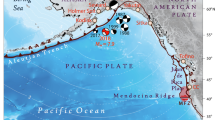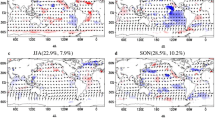Abstract
Time series observations from instruments sited in the deep ocean and along coastal margins of the Pacific during major tsunami events in the years since 2010 were systematically processed. Examination of these records during four events, 2010 Chile (Maule), 2011 East Japan (Tohoku), 2012 Haida Gwaii and 2014 Chile (Iquique), show the prevalence of a small negative phase leading the first major positive tsunami wave, a phase that is not typically reproduced by current modelling approaches. We present leading negative phase signatures in examples from the more than 40 deep-ocean bottom pressure and approximately 200 tide gauge records investigated for this study. High sampling rate time series (15-s) were given greater weight in our investigation than the more readily available 1-min series. Careful investigation of tsunami arrival at each deep-ocean site highlights the role filtering techniques may play in misleading researchers or masking specific tsunami features such as the leading negative phase that is the basis of this study. The main focus of this investigation is to characterise the scale and repeatability of the phenomenon in support of recent similar findings rather than to provide a definitive explanation as to the cause. In general, our findings are in good agreement with and support the theoretical results of Watada et al. (J Geophys Res Solid Earth 119:4287–4310, 2014).











Similar content being viewed by others
References
Allen, A. L., Donoho, N. A., Duncan, S. A., Gill, S. K., McGrath, C. R., Meyer, R. S., and Samant, M.R.N. (2008), NOAA’s National Ocean Service Supports Tsunami Detection and Warning through Operation of Coastal Tide Stations. Solutions to Coastal Disasters 2008: pp. 1–12; doi:10.1061/40978(313)1
Allgeyer, S., and Cummins, P. (2014), Numerical tsunami simulation including elastic loading and seawater density stratification, Geohys. Res. Lett., 41, 2368-2375; doi:10.1002/2014GLO59348.
Atwater, B. F., Musumi-Rokkaku, S., Satake, K., Yoshinobu, T., Kazue, U., and Yamaguchi, D. K. (2005). The Orphan Tsunami of 1700 – Japanese Clues to a Parent Earthquake in North America. U.S. Geological Survey Professional Paper 1707. United States Geological Survey-University of Washington Press. 98 pp. ISBN 978-0295985350.
Borrero, J. C., and Greer, S. D. (2013), Comparison of the 2010 Chile and 2011 Japan tsunamis in the far field, Pure Appl. Geophys., 170, 1249-1274; doi:10.1007/s00024-012-0559-4.
Cassidy, J. F., Rogers, G. C., and Hyndman, R. D. (2013), An overview of the October 28, 2012 Mw 7.7 earthquake in Haida Gwaii, Canada: a tsunamigenic thrust event along a predominantly strike-slip margin, Pure Appl. Geophys., 171, 3457–3465; doi:10.1007/s00024-014-0775-1.
Delouis, B., Nocquet, J. M., and Valle, E. M. (2010), Slip distribution of the February 27, 2010 M w = 8.8 Maule earthquake, central Chile, from static and high-rate GPS, InSAR, and broadband teleseismic data, Geophys. Res. Lett., 37, L17305, doi:10.1029/2009GL043899.
Dunbar, P. K., Stroker, K. J., Brocko, V. R., Varner, J. D., McLean, S. J., Taylor, L. A., Eakins, B. W., Carignan, K. S., and Warnken, R. R. (2008), Long-term tsunami data archive supports tsunami forecast, warning, research and mitigation, Pure Appl. Geophys. 165, 2275-2291.
Eblé, M. C., and González, F. I. (1991), Deep-ocean bottom pressure measurements in the Northeast Pacific, J. Atmos. Ocean. Tech. 8(2), 221–233.
Eblé, M. C., Titov, V., Denbo, D., Moore, C., Mungov, G., and Bouchard, R. (2011), Signal-to-noise ratio and the isolation of the 11 March 2011 Tohoku tsunami in deep-ocean tsunameter records, OCEANS ‘11 MTS/IEEE KONA, http://www.oceans11mtsieeekona.org/
Eblé, M., Mungov, G., Rabinovich, A., Harris, E., Titov, V. (2012), Spatial and Temporal Characterization of the 11 March 2011 Tsunami. AGU Fall Meeting, San Francisco, 3-7 December 2012, Abstract NH11C-1563.
Fine, I. V., Kulikov, E. A., and Cherniawsky, J. Y. (2013), Japan’s 2011 tsunami: Characteristics of wave propagation from observations and numerical modelling. Pure Appl. Geophys., 170, 1295-1307; doi:10.1007/s00024-012-0555-8.
Fine, I. V., Cherniawsky, J. Y., Thomson, R. E., Rabinovich, A. B., and Krassovski, M. V. (2015), Observations and numerical modeling of the 2012 Haida Gwaii Tsunami off the coast of British Columbia, Pure Appl. Geophys. 172 (3-4), 699-718; doi:10.1007/s00024-014-1012-7.
Foreman, M. G. G. (1977, revised 2004). Manual for Tidal Heights Analysis and Prediction. Pacific Marine Science Report. 77-10. Institute of Ocean Sciences, Patricia Bay, 58 pp. http://www.pac.dfo-mpo.gc.ca/science/oceans/tidal-marees/index-eng.htm.
Foreman, M. G. G., Cherniawsky, J. Y., and Ballantyne, V. A. (2009), Versatile Harmonic Tidal Analysis: Improvements and Applications. J. Atmos. Oceanic Technol. 26, 806–817. doi:http://dx.doi.org/10.1175/2008JTECHO615.1
Inazu, D., and Saito, T. (2013), Simulation of distant tsunami propagation with a radial loading deformation effect, Earth Planets Space 65, 835–842.
Kelly, G. (2004). Ammianus and the Great Tsunami. Journal of Roman Studies 94, 141–167; doi:10.2307/4135013. JSTOR 4135013.
Matsumoto, H., and Kaneda, Y. (2013), Some features of bottom pressure records at the 2011 Tohoku earthquake - Interpretation of the far-field DONET data. Proceed. 11th SEGJ Intern. Symp.
Mofjeld, H. O. (2009), Tsunami measurements. In The Sea, Volume 15: Tsunamis (eds. A. Robinson and E. Bernard), (Harvard University Press, Cambridge, MA, 2009) pp. 201–235.
Mungov, G., Eblé, M., and Bouchard, R. (2013). DART tsunameter retrospective and real-time data: A reflection on 10 years of processing in support of tsunami research and operations. Pure Appl. Geophys., 170, 1369-1384; doi10.1007/s00024-012-0477-5.
Parker, B. (2007), Tidal Analysis and Prediction, NOAA Special Publication NOS CO-OPS 3; 378 pp.
Rabinovich, A. B., and Eblé, M. C. (2015), Deep ocean measurements of tsunami waves, Pure Appl. Geophys., 2015, 172 (this issue); doi: 10.1007/s00024-015-1058-1.
Rabinovich, A. B. and Thomson R. E. (2007), The 26 December 2004 Sumatra tsunami: Analysis of tide gauge data from the World Ocean Part 1. Indian Ocean and South Africa. Pure Appl. Geophys 164 (2/3), 261-308.
Rabinovich, A. B., Stroker, K., Thomson, R., and Davis E. (2011), DARTs and CORK in Cascadia Basin: High-resolution observations of the 2004 Sumatra tsunami in the northeast Pacific, Geophys. Res. Lett. 38, L08607, 5 pp., doi:10.1029/2011GL047026.
Rabinovich, A. B., Thomson, R. E. and Fine I. V. (2013a). The 2010 Chilean tsunami off the west coast of Canada and the northwest coast of the United States. Pure Appl. Geophys., 170, 1529-1565.
Rabinovich, A. B., Candella, R. N., and Thomson, R. E., (2013b), The open ocean energy decay of three recent trans-Pacific tsunamis. Geophys. Res. Lett., 40, doi:10.1002/grl.50625.
Saito, T., Ito, Y. Inazu, D., and Hino, R. (2011), Tsunami source of the 2011 Tohoku-Oki earthquake, Japan: Inversion analysis based on dispersive tsunami simulations, Geophys. Res. Lett, 38, L00G19, doi:10.1029/2011GL049089.
Shevchenko G., Ivelskaya T., Loskutov A. and Shishkin A. (2013) The 2009 Samoan and 2010 Chilean tsunamis recorded on the Pacific coast of Russia, Pure Appl. Geophys. 170, 1511-1527.
Simons, M., et al. (2011), The 2011 magnitude 9.0 Tohoku-Oki earthquake: Mosaicking the megathrust from seconds to centuries, Science, 332 (6036), 1421–1425; doi:10.1126/science.1206731.
Song, Y. T., Fukumori, I. Shum, C. K., and Yi, Y. (2012), Merging tsunamis of the 2011 Tohoku-Oki earthquake detected over the open ocean, Geophys. Res. Lett., 39, L05606, doi:10.1029/2011GL050767.
Thomson, R. E., Fine, I. V., Rabinovich, A. B., Mihaly, S. F., Davis, E. E., Heesemann, M., and Krassovski, M. V. (2011), Observations of the 2009 Samoa tsunami by the NEPTUNE-Canada cabled observatory: Test data for an operational regional tsunami forecast model, Geophys. Res. Lett., 38, L11701, doi:10.1029/2011GL046728
Thomson, R. E. and Emery, W. J. (2014), Data Analysis Methods in Physical Oceanography: 3 rd Edition. Elsevier Science, Amsterdam, London, New York (August 2014), 716 pp.
Tsai, V. C., Ampuero, J.-P., Kanamori, H., and Stevenson D. J. (2013), Estimating the effect of Earth elasticity and variable water density on tsunami speeds, Geophys. Res. Lett., 40, 492–496, doi:10.1002/grl.50147.
Uslu, B., Power, W., Greenslade, D., Titov, V.V., and Eblé, M. (2011), The July 15, 2009 Fiordland, New Zealand tsunami: Real-time assessment. Pure Appl. Geophys., 168 (11), doi:10.1007/s00024-011-0281-7, 1963–1972
Viana-Baptista M. A., and Soares P. M. (2006), Tsunami propagation along Tagus estuary (Lisbon, Portugal) preliminary results. Science of Tsunami Hazards; 24(5):329 Online PDF. Accessed 2015-05-9. Archived 2009-05-27.
Watada, S. (2013), Tsunami speed variations in density-stratified compressible global oceans, Geophys. Res. Lett., 40, 4001–4006, doi:10.1002/grl.50785.
Watada, S., Kusumoto, S., Fujii, Y., and Satake, K. (2012), Cause of delayed first peak and reversed initial phase of distant tsunami. AGU Fall Meeting, San Francisco, 3-7 December 2012, Abstract NH43B-1649.
Watada, S., Ksumoto, S. and Satake, K. (2014), Traveltime delay and initial phase reversal of distant tsunamis coupled with the self-gravitating elastic Eart. J. Geophys. Res. Solid Earth, 119, 4287–4310, doi:10.1002/2013JB010841.
Wei, Y., Chamberlin, C. Titov, V., Tang, L., and Bernard, E. N. (2013), Modeling of the 2011 Japan tsunami – Lessons for near-field forecast. Pure Appl. Geophys., 170 (6–8), 1309–1331; doi:10.1007/s00024-012-0519-z.
Acknowledgments
The authors thank the National Data Buoy Center and the National Ocean Service for their dedication in securing quality observations, the National Tsunami Warning Center for providing many coastal data sets, and Lindsey Wright and NOS Pacific, especially Caleb Gostnell, for the many hours invested in calling tide gauge backup units and manually downloading the 15-s data that are the basis of our investigations. We also thank Karen Birchfield for her assistance with graphics and the reviewers for taking the time to provide candid and greatly appreciated comments for manuscript improvement. The contribution of Alexander Rabinovich was partially funded under NOAA/PMEL Contract Number WE-133R-13-SE-1659 and by the Russian Science Foundation Grant 14-50-00095. This is PMEL contribution 4099.
Author information
Authors and Affiliations
Corresponding author
Rights and permissions
About this article
Cite this article
Eblé, M., Mungov, G. & Rabinovich, A. On the Leading Negative Phase of Major 2010–2014 Tsunamis. Pure Appl. Geophys. 172, 3493–3508 (2015). https://doi.org/10.1007/s00024-015-1127-5
Received:
Accepted:
Published:
Issue Date:
DOI: https://doi.org/10.1007/s00024-015-1127-5




